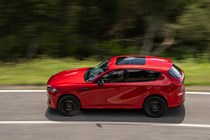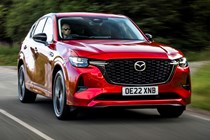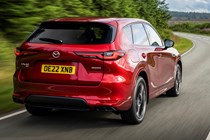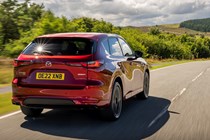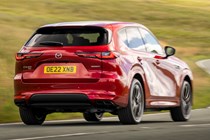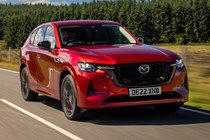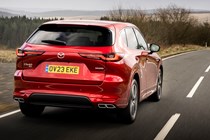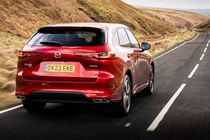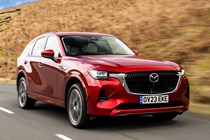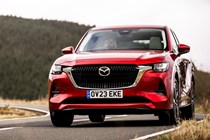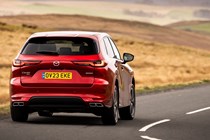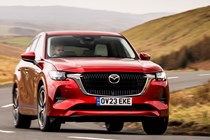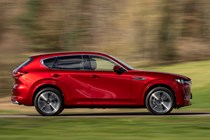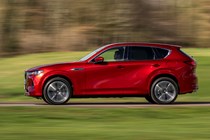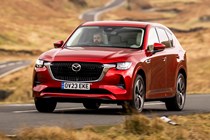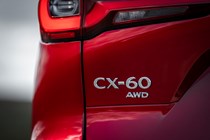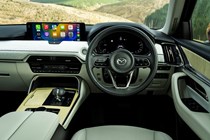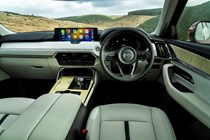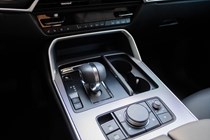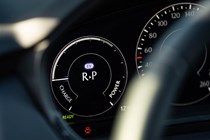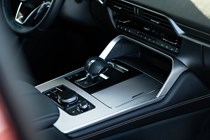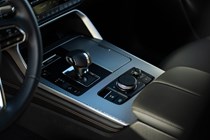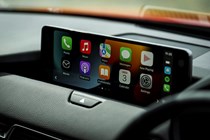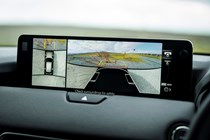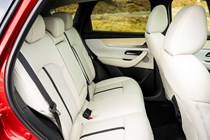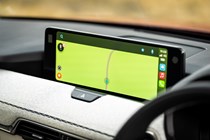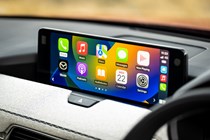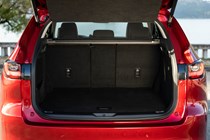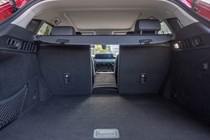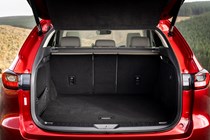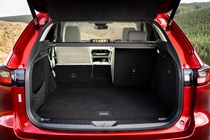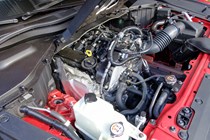
Mazda CX-60 long-term test
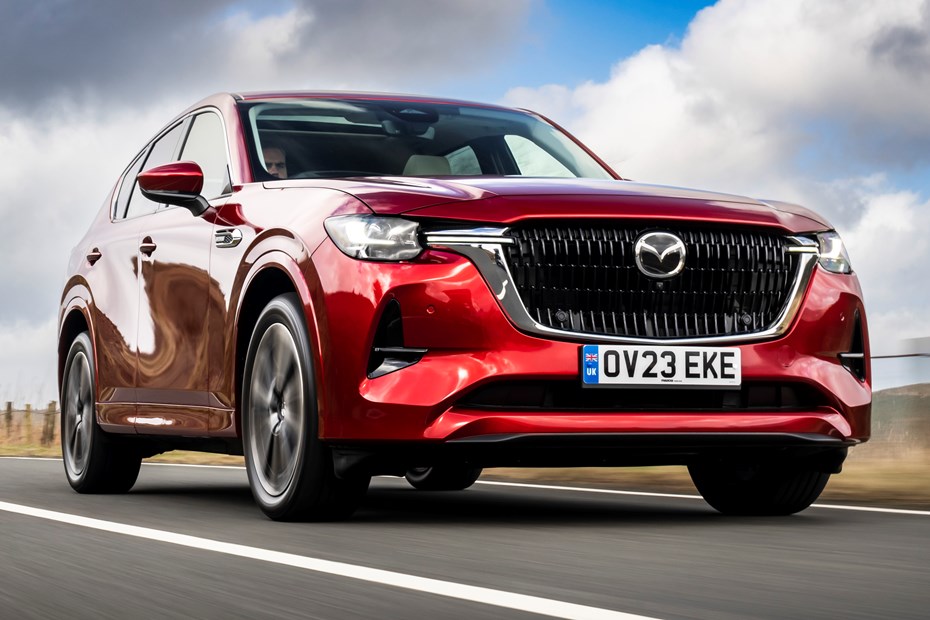

The CX-60 represents something of a diversion for Mazda, pushing the brand into the premium SUV marketplace and taking on the likes of BMW, Audi and Mercedes-Benz. That’s a big ask for the Japanese firm, but it’s coming out all guns blazing, with a range that includes this unique diesel engine. I’m going to spend six months finding out whether it’s been a successful ascent towards best-in-class, or if there’s still a way left to climb.
Reports by Gareth Evans
Jump to:
Update 1: Welcome to the fleet
Having read many opinions on the Mazda CX-60 but with no prior chance to drive it, I was seriously curious about this car when it arrived. The spec sheet is among the most interesting I’ve read in recent memory, you see. While Mazda predicts 85% of sales will be of the plug-in hybrid model Tom and Richard tested before, there are still people out there who need a large-ish premium diesel SUV, and I’m one of them.
To sate desires in that corner of the market, Mazda has developed a new engine for this car, and it’s the primary reason I’m so curious. It’s a whopping 3.3 litres in capacity and is the only diesel car engine currently on sale that does without a turbocharger, instead relying on mild hybrid technology to keep it efficient enough to pass emissions regulations.
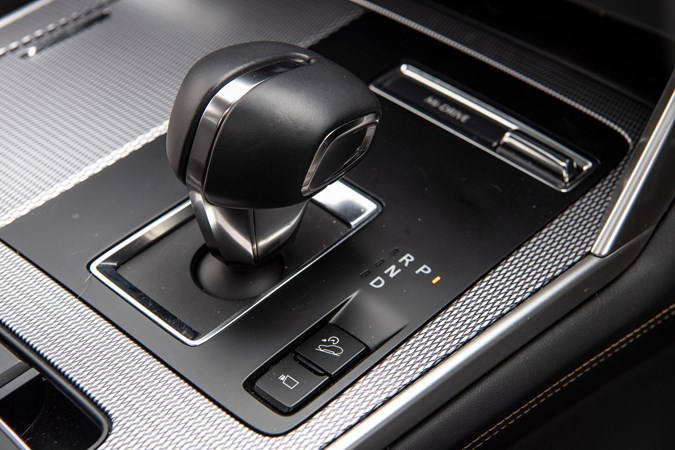
Furthermore, it’s an inline-6 engine, which means it should be extremely smooth, and with 254hp it’s also remarkably powerful. But it’s the 550Nm of pulling power that I’m more interested in, because I want to do some towing this year, and there’s an ever-dwindling supply of cars capable of pulling anything larger than a handbag nowadays. This car has a braked towing weight of 2500kg, which should be more than ample for the racing cars I’d like to drag.
For that reason one of the optional extras on board is a retractable towbar, costing £1104.94.
I’ll go into the other options installed shortly, but first let’s explore standard equipment. This one’s in Homura trim, meaning on the outside you get 20-inch alloys, black grilles and mirrors, adaptive LED headlights and tail lights, and rear privacy glass.
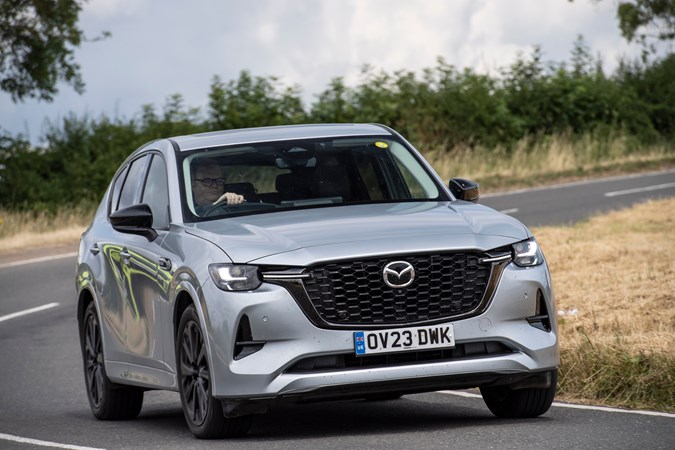
Inside it’s rammed with equipment, with highlights including a head-up display, electric front seats, an electrically adjusted heated steering wheel, facial recognition to adjust seats, mirrors and steering wheel to your settings, and an impressive infotainment system featuring wireless Android Auto and Apple CarPlay, a 12.3-inch screen, and a Bose stereo with 12 speakers.
There is also an impressive list of safety kit, including automatic braking, driver monitoring, traffic sign recognition, blindspot monitoring and lane-departure warning.
But on top of all of that lot, there are some additional extras installed. The panoramic sunroof (£1000) should be a nice touch in summer because it opens to let air in for low-speed pottering, and makes the otherwise dark cabin feel a lot lighter. Thankfully there’s also a retractable sunshade for warm weather too, because these roofs can have the cabin heating up a lot.
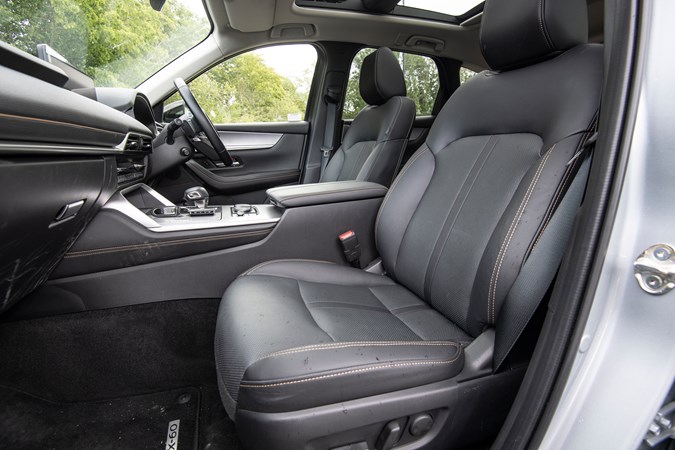
The Convenience and Driver Assistance package (£1900) adds wireless smartphone charging, a 150W AC socket, additional automatic braking and cross-traffic alerts, and radar-guided adaptive cruise control.
In fact, given the extensive list of features installed on this car, it seems to me that Mazda is making a real premium play here. This spec wouldn’t be out of place on a Land Rover.
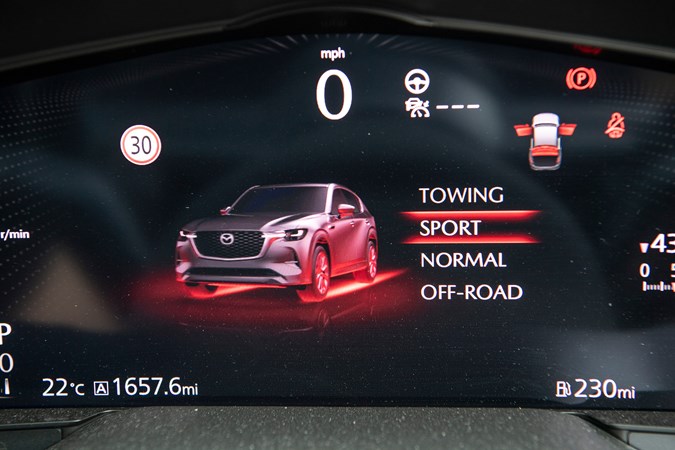
It’s even got Off-road and Towing drive modes, alongside Sport and Normal. I’ll look forward to testing that little lot out along the way.
And therein lies the big question here: can Mazda really mix it with the upper echelons of the premium medium SUV segment, and take on the BMW X3, Volvo XC60 and Mercedes-Benz GLC? I’m very excited to find out…
Update 2: Mazda CX-60 drives at Le Mans
SUV takes on support car duties as Gareth races at the Le Mans Classic
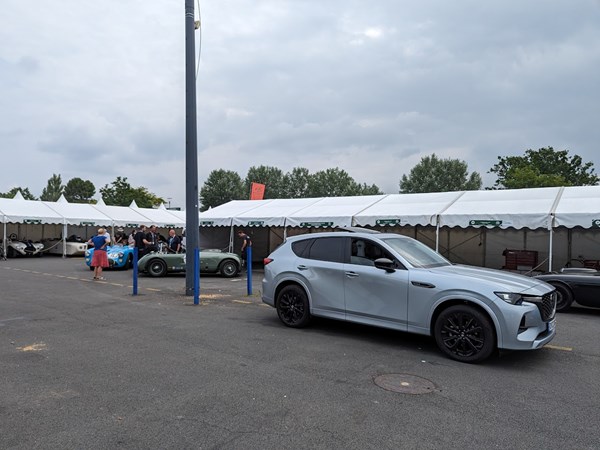
After seven years of planning and a lot of hard work, in July it was finally time for the race team I drive for to head back to Le Mans Classic. You can read about my adventure over on the Car Magazine website, but the point to this article is that I was lucky enough to take the Mazda CX-60 along as a support car.
This trip gave me ample opportunity to assess the comfort, performance, range and handling of this mid-sized SUV, and furthermore find out what its practicality is like.
There were 14 of us in total, staying in a house 30 minutes from the circuit, so alongside the long-distance jaunts there and back, there was a fair amount of ‘ferrying’ to and fro.
The car was used a lot, because it was the biggest our group had, and often carried five people, including some renowned engine and suspension experts. Frankly, you couldn’t ask for a better set of circumstances in which to test a car’s capabilities.
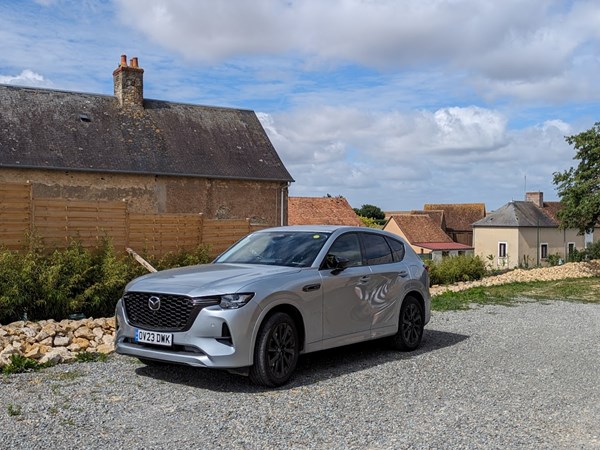
We even did a spot of light off-roading, but only across fields in order to park, so I’ll cover that side of the ‘60’s talents in a future update.
So, taking things in order, how did it do? We’d booked a hotel near the Eurotunnel in anticipation of an early train, so I asked Google to navigate me there using voice control and Android Auto did the rest, setting the fastest route there automatically. We only had two people for this part of the journey, and the rest of the room in the car was taken up with all manner of racing detritus and luggage. It’s amazing what you need to do an event like this, from deck chairs to cooking utensils and of course all the race kit.
Android Auto didn’t tell me about the Dartford Crossing toll, though, so this was a particularly expensive journey because I forgot to pay it. I enjoyed a £37.50 fine for my incompetence. This is in no way the fault of the vehicle, although it has crossed my mind that it might be useful to get a reminder of such things when you reach your destination. Perhaps someone from Google will read this and take action…
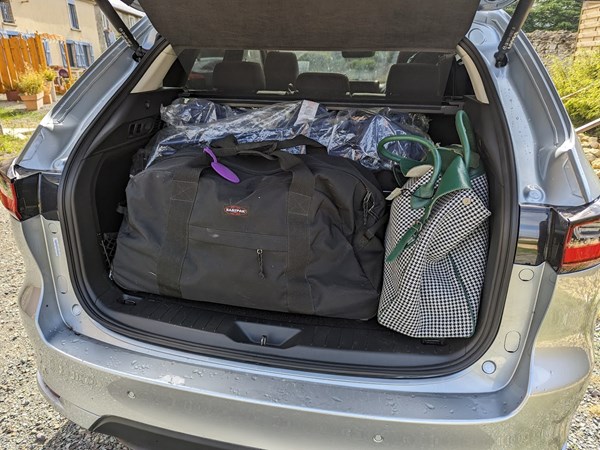
Anyway, the Folkstone hotel thoroughly slept in, we headed down to the Tunnel early the next day. We’d planned to arrive at our house near Le Mans around mid-afternoon. On the way through passport control and customs, we encountered our first height restriction, and it quickly became obvious my nerves were going to be stress-tested.
You see, the Mazda (somehow) qualifies as a ‘small’ car as far as Eurotunnel is concerned. But only just. If you’ve ever driven a vehicle through a barrier that’s close to the roof of the car, you’ll know just how worrying an experience it can be, and the worst bit is that the barrier is only the start: it’s there for a reason, and that reason is it’s also the minimum height of the interior of the train’s carriage.
So, pulling onto the train it felt like an incredibly tight fit. The width of the tyres seemed millimetres from the edges of the track you need to drive along, and the ceiling in the joins between carriages felt so near that I almost ducked.
It’s only at this point you realise just how long these trains are – it felt like I drove most of the way to Calais by the time we were instructed to stop, put the handbrake on and open our windows half way.
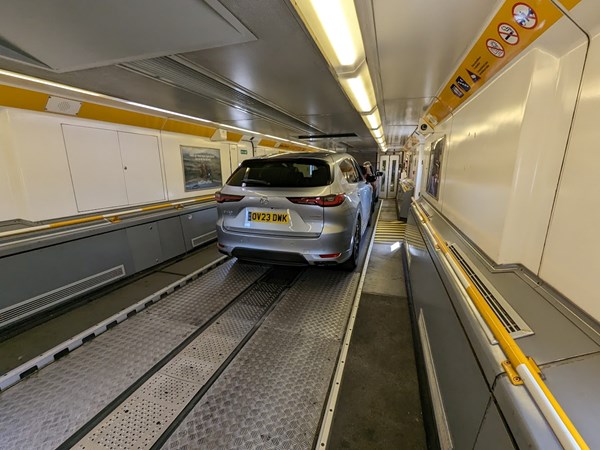
Such is the paradox of this car. It’s not as huge as it feels. The steering is heavy and the seating position high, so it does a fantastic impression of Range Rover-sized, but in reality its dimensions are more akin to a BMW X3.
However, heading out onto the French Autoroute, all of a sudden that perceived size and performance of the car came into its own. At 81mph it feels truly solid in every sense, and the masses of torque from the 3.3-litre diesel make over-taking trucks a simple matter. It even sounds great, with a deep inline-six bellow that rises with the revs. This type of engine is a dying breed, and that feels like a shame to me, even though it’s hardly the most frugal in terms of fuel economy, presenting between 43-44mpg depending on usage.
The eight-speed automatic gearbox deserves special mention here, because it’s so smooth it’s nearly impossible to tell when it’s shifting gears during normal driving. It gets a little more obvious when you’re moving quickly, but it’s in no way jerky and always has the right gear on offer. I came to thinking that this is actually one of the better automatics I’ve ever driven.
Mazda CX-60 driven around the Le Mans circuit… sort of
Once we’d arrived at our house (a few days earlier than the racing began), we decided to take the opportunity to visit the circuit. You see, much of the famous track comprises public roads, with authorities only shutting them off for the 24-hour race each year and the Le Mans Classic event every other year.
So, long story short, we drove as much of the circuit as we could in the Mazda, just to get familiar with how it looked and felt. There are no test days or track days here to learn the track, so this was a valuable exercise. It was also an excuse to give Sport mode a workout, along with the paddleshift gearchange, and this had the engine feeling sharper and sounding better than ever before.
Sure, there’s a bit of bodyroll in bends, but actually the CX-60 has handling we’ve come to expect of Mazda; a company with a history of race wins at this very track. It’s alert, predictable and extremely quick to change direction.
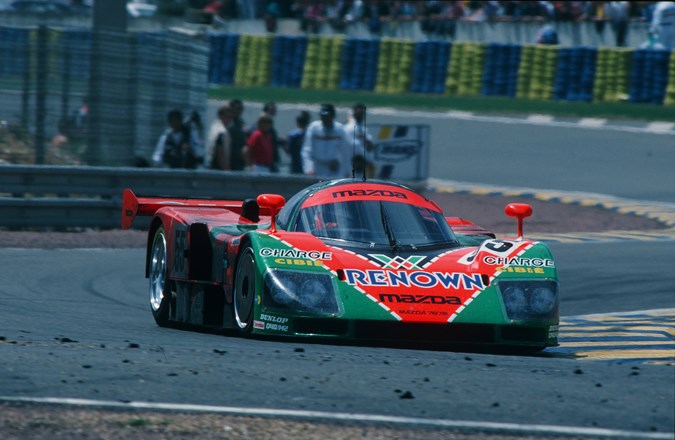
In fact, the only chassis criticism didn’t come from me. A back-seat passenger noted that the rear suspension was very hard when five adults up, and the outer rear seats didn’t have enough padding for support when cornering. I wasn’t going too fast, I promise!
The weather is worth a mention here too. Le Mans is often on the warm side, being a long way from any sea breeze, right smack bang in the middle of France. It was over 25 degrees every day, and where the car is concerned I was thankful for two things: the ventilated front seats, which were on the majority of the time to keep my nether regions cool, and the blind for the panoramic roof, which stopped the cabin from becoming an oven when parked up in the sun.
The Mazda really came into its own when transporting our gear to the paddock, though. There were five of us, the 570-litre boot was completely full and I had to navigate a considerable crowd to get to where we needed to be for having the race car – a 1952 Allard J2X Le Mans – put through scrutineering. Accuracy and patience were the order of the day, and again the smooth gearbox and heavy steering played a huge role in keeping pedestrians safe…
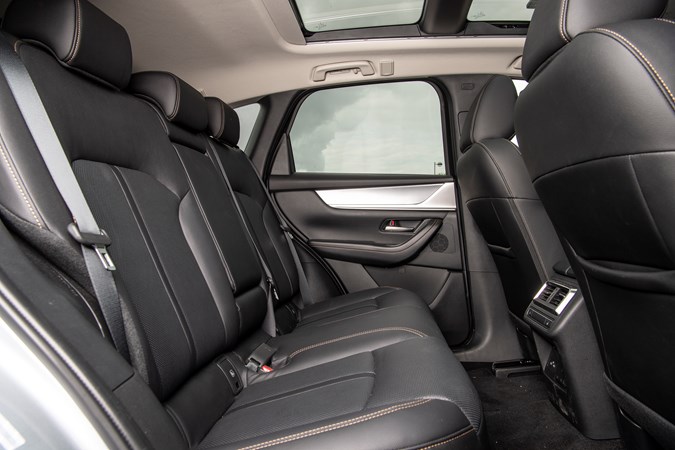
The rest of the race weekend went as well as these things tend to do, with highs and lows (please see my CAR article for more) and in what seemed like no time at all, we had to head home. I filled the car up twice on this trip, which is a ringing endorsement of the 52-litre fuel tank.
On the chilled drive back to the Tunnel I did notice an oddity with the active lane-keeping system, though. It would tend to keep me a little too far to the right of my lane, which meant it also thought I was getting too close to vehicles I was overtaking.
The result was the cruise control knocking off speed as if I were behind the slower-moving traffic rather than alongside, and this soon got irritating enough for me to switch it off altogether. This hasn’t been an issue in the UK, which would tend to indicate it’s my issue rather than the car’s, but I honestly thought my lane placement was pretty good.
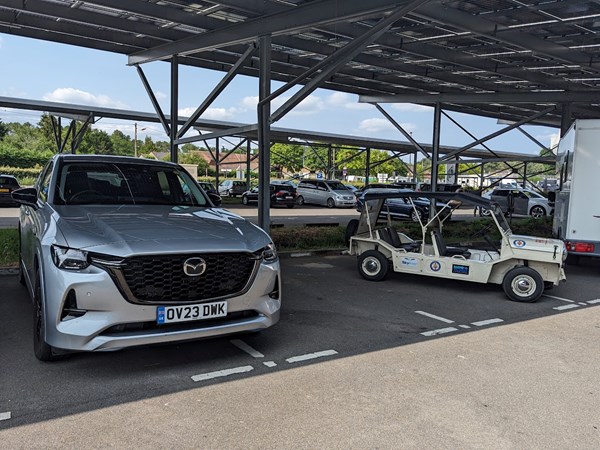
Anyway, after squeezing through the train for the second time, soon enough I found myself on the depressing M20 and on the final straight towards home.
The CX-60 proved a hugely comfortable, capable companion for this adventure, and in the process, really wound its way into my affections. It’s such a well-rounded vehicle.
Update 3: Towing with the Mazda CX-60
The SUV is given a real test, with a racing car hitched to its rear end

The Mazda CX-60 continues to impress. This time, I’ve been towing a racing car, and it’s done a fantastic job.
Its task was to get the Ford Ka we were racing down to Brands Hatch and back the following day. After going to collect the car on its Brian James twin-axle trailer up on Friday lunchtime, we faced our first hurdle… it’s always fun trying to reverse the rear of the car close enough to the hitch to connect the trailer.
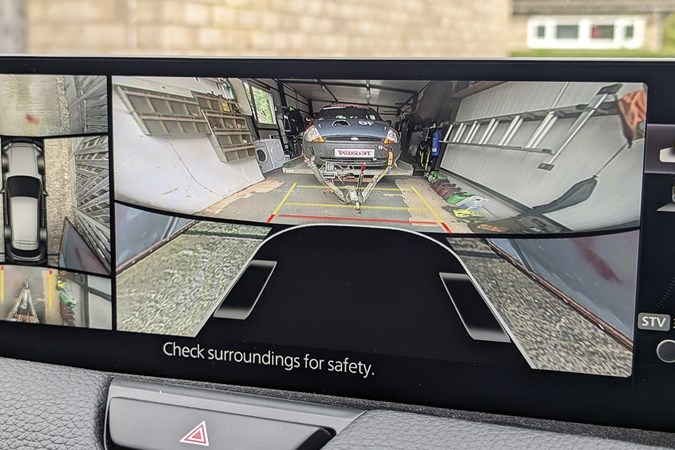
Luckily for me, the CX-60 has a handy rear-view camera that makes it simple: just align the thing you want to tow with the red line displayed on the screen and you’ll be within centimetres of the ball. Anything that takes the guesswork out of doing this is a good thing, in my book.
Does the Mazda CX-60 need an adaptor for towing?
One thing you need to know about towing a trailer with a Mazda CX-60 is that you’re likely to need an adaptor. The Brian James twin-axle that I was using has seven-pin electronics, whereas the Mazda has a 13-pin socket, meaning that before you’re able to plug into power you’ll need to spend a few quid on a convertor before towing most trailers.
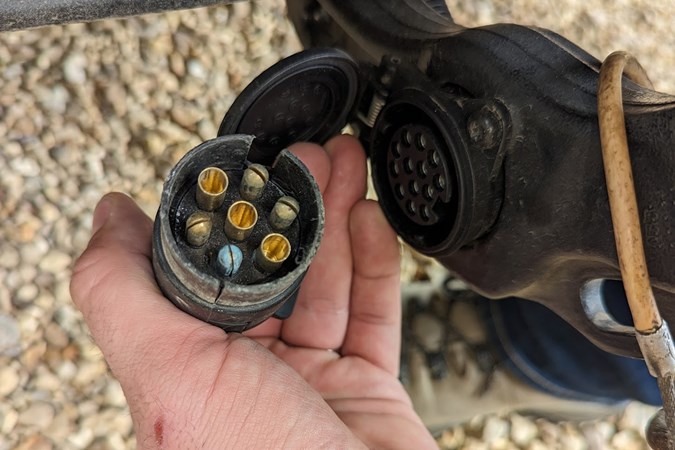
Anyway, that sorted, it was time to fire up the car and head off. Except it wasn’t, because the dash showed me that we had a blown bulb on the trailer. Pretty useful feature, that.
Bulb changed and this time we really were ready to go.
Introducing the Mazda CX-60’s towing mode
Once the trailer was hitched to the car’s towbar, which costs an additional £1100 and deploys via a button in the boot, and the electrics plugged in I was informed that Towing Mode was now available. This clever system changes the character of the engine, gearbox and four-wheel drive system to suit towing heavy loads. It holds on to gears longer, allowing the engine to sit at higher revs for more engine braking, making the car seem more stable.
With this engaged, the car felt exceptionally confident on the road. At 60mph on the motorway you’d barely believe there was around 1000kg strapped to the back. At one point I had to brake fairly firmly when a lorry pulled out, and it pulled up in a predictable fashion with no weaving or dramatics.
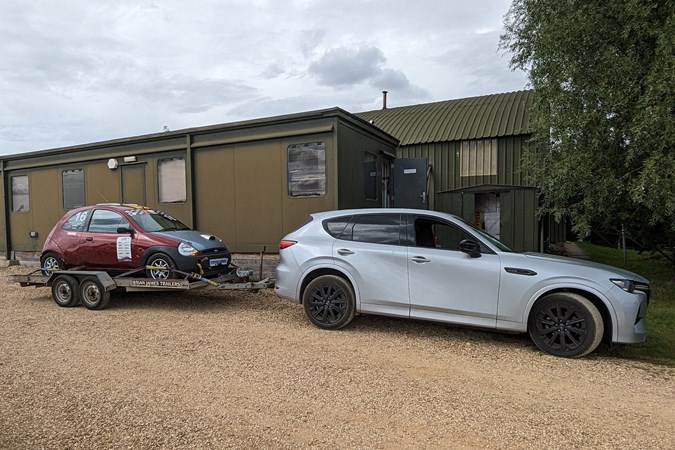
On the way home it rained a considerable amount, and again the car just brushed it off and carried on.
Reversing with the trailer – a notoriously difficult thing to do accurately – was nice and easy as well, because you’re sat very high in the CX-60, with excellent vision all around the car. The steering is heavy but accurate, with a surprisingly small turning circle given the perceived dimensions of the vehicle.
How’s the fuel economy when towing?
Towing isn’t great for fuel economy at the best of times. The shape of a car on a trailer catches a lot of air and causes serious wind resistance, so I wasn’t expecting a particularly frugal run, but the CX-60’s big, smooth diesel was still doing over 40mpg for this adventure. That’s pretty impressive if you ask me.

In fact, that word neatly sums up how I’m feeling about he CX-60 in general right now. It’s deeply impressive car in so many ways.
As a footnote, if you want to tow anything with the CX-60, it doesn’t matter which version you pick: all have the very same 2500kg braked towing capacity, including the plug-in hybrid.
Update 4: Impressive electrickery
There’s a vast amount of tech on the CX-60. Gareth is your guide…
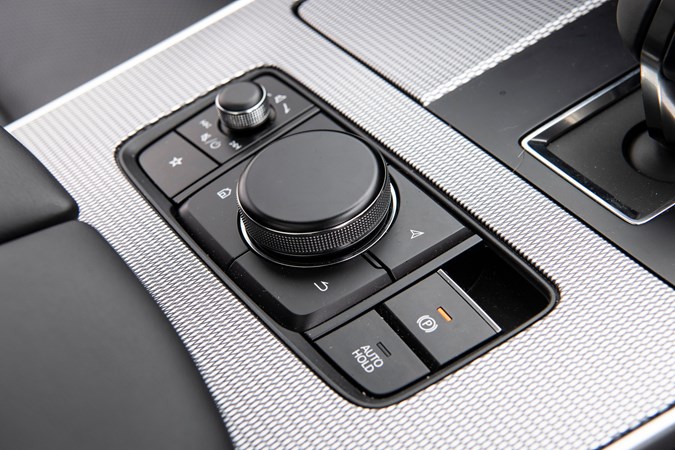
The latest instalment of my saga with Mazda’s excellent mid-sized diesel SUV, the CX-60, I’m going to dive into the technology it has on board.
There’s a lot to talk about here, and I’m going to start at the back of the car. The electrically powered boot is a marvel – not only can you operate it from the keyfob or via the button on the bootlid, you’re also able to waggle a foot underneath the rear bumper to open it with both hands full. Mazda isn’t alone in offering this, but it’s a seriously helpful feature. There’s also a 12-volt socket for charging a tyre inflator so you don’t have to disturb passengers if you get a puncture.
Now, let’s move into the back seats of the car. You don’t often get a lot of tech here, but alas Mazda has provided well: not only are there two USB-C chargepoints for high-speed smartphone charging, but there’s a three-pin plug just like you get at home too. This means you’re able to plug in regular devices. Fancy a brew? Bring a kettle! And some water, obviously…
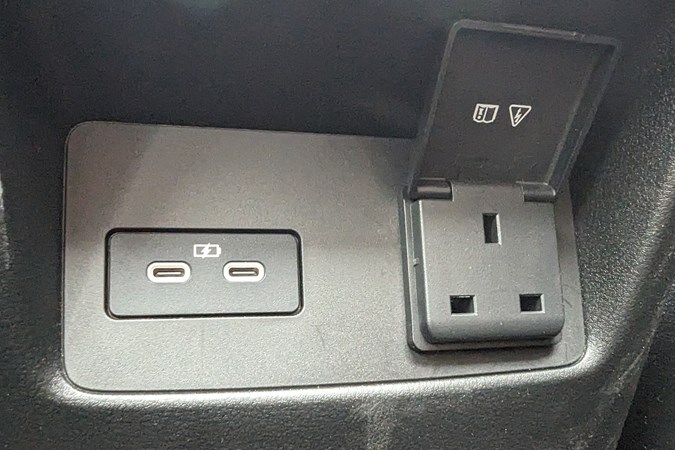
The outer two rear seats are heated too, which hasn’t been much of a bonus during the summer I’ve spent with the car, but as we move towards mid-October it looks like the mercury is about to fall rapidly so I’m sure they’ll get some use.
In the handy cubby betwixt the two front seats there’s a further two USB-C sockets and I’ve come to like these, because they’re quicker than the wireless charging pad in front of the gear lever, don’t make my phone as hot (a common problem with wireless recharging) and keep my phone hidden away safely.
Next to the wireless pad is another 12-volt socket, too.
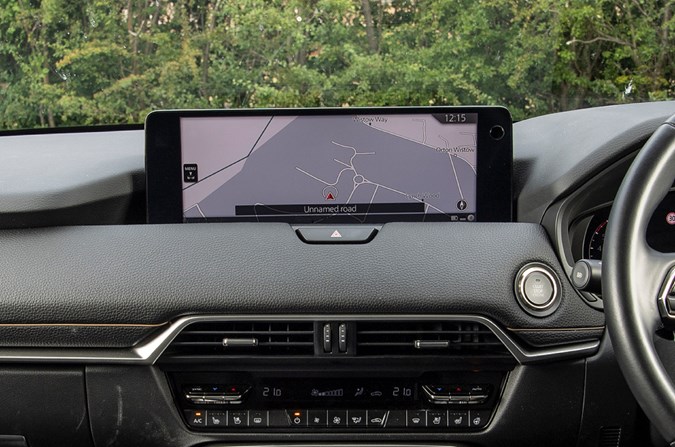
Moving on to the multimedia system, then. Blimey, this has impressed me. Thumb the engine start button and the first thing that happens is the car recognises me.
Yes, you read that right: it’s got facial recognition installed, which scans your face with a camera and if you’ve set it up, will then adjust the driver’s seat, steering wheel position and door mirrors to your desired position. If you share the car with anyone else, this is a neat labour-saving solution that you’ll quickly come to appreciate.
After that’s done, the system begins its normal operation, offering a massive range of features all controlled via the large rotary selector and a bunch of buttons, either between the front seats or on the steering wheel.

I’ve already written about the brilliant wireless Android Auto in these updates, and the fact that I love the amount of physical buttons on offer rather than having to rely on delving into touchscreen menus like some other cars.
But you’ve also got DAB radio, full Bluetooth connectivity, voice control, built-in sat-nav (that I’ve yet to use due to the Android Auto), vehicle diagnostics and performance readouts, and of course everything you need to personalise the sound from the 10 Bose speakers.
Below the large screen you have more physical controls for the heating, featuring dual-zone climate control alongside heating and ventilation for the front seats and heating for the steering wheel.
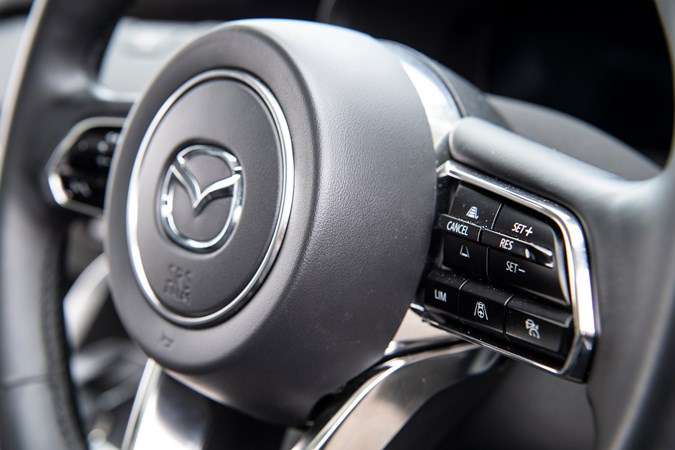
Moving over to the steering wheel itself, there are buttons for the built-in adaptive cruise control that is seriously simple to use. You set speed by pushing the right-hand button up or down, and then adjust the speed by doing the same thing, in 1mph increments or 5mph steps if you hold it. I use this in roadworks a lot.
Then on the right-hand side of the steering wheel you find a bunch of buttons that allow you to switch off certain systems, such as stop-start, traction control, parking sensors and proximity sensors. There are also two preset buttons for seating position and a boot-opening button.
I think you’ll agree that little lot adds up to impressive levels of electrickery. Impressive stuff, if you ask me…
Update 5: A fond farewell
Gareth’s time with the CX-60 comes to an end, and it’s far, far too soon

It’s time to bid a fond farewell to a car I’ve become rather attached to. The Mazda CX-60 diesel has been a charismatic, capable and cost-effective companion for the summer, and I’m genuinely sad to see it go.
Its main appeal for me was its versatility, taking on towing, long-distance trips, some light off-roading and everyday rural duties without any trouble at all.
The towing capability in particular impressed me greatly. It’s got loads of tech to help such as a dedicated drive mode, a handy reversing camera and neat hidden tow ball that pops out when you push a button in the boot.
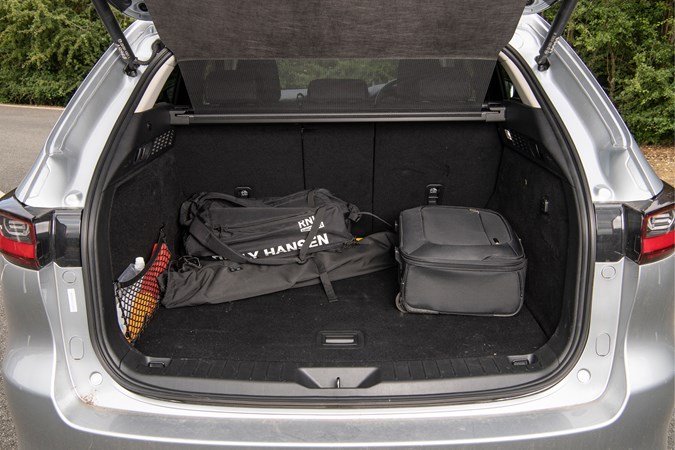
And all that is coupled with a brilliant diesel engine, which is smooth, punchy and even sounds great. It does a good job of making this the most premium-feeling Mazda I’ve ever driven, and I’ve driven quite a few…
The car’s multimedia system deserves special credit too, again adding to the impression that this is a special car. It’s effortless to use, with wireless connectivity to my smartphone, and the screen is large and clear.
I love all the physical controls in the cabin as well. Once you’ve got your head around the cabin layout it’s a joy to use, and far easier than a lot of modern screen-reliant systems.
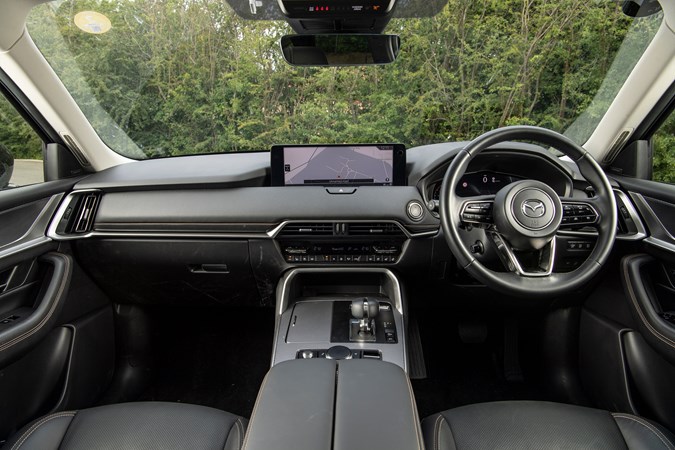
The interior is a lovely place to be. The front seats are wonderfully comfortable, are heated, ventilated, and the driver’s one can even automatically adjust by ‘recognising’ your face with a camera, along with the door mirrors and steering wheel. The latter is heated too, which I’ve really enjoyed on the colder days.
A jaunt into France for Le Mans Classic gave me a chance to test its touring capabilities and it impressed me there too, tackling long distances with ease and never missing a beat.
My main criticism is that it’s a car that loves a ‘bong’, though. Sometimes it feels as though it’s constantly warning me of something or other, which has the effect of notification fatigue. It keeps telling me I’m a distracted driver when I’m really not; I’m not sure what signals it’s drawing those conclusions from, but my concentration levels when I drive are fairly high.

The lane-keeping technology doesn’t work particularly well for rural lanes either, at times trying to steer me back into the middle of the road when I’m trying to nudge over to make way for an oncoming vehicle on country lanes. This isn’t a problem unique to the Mazda, though, in fairness. It happens with most cars I drive nowadays.
But these tiny niggles wouldn’t stop me from heartily recommending the CX-60 diesel to anybody in the market for such a vehicle.
It’s confident, well-mannered and by far the most interesting car in its class. And furthermore, given the option I’d buy one with my own money. I’ll take mine in Soul Red and silver wheels.
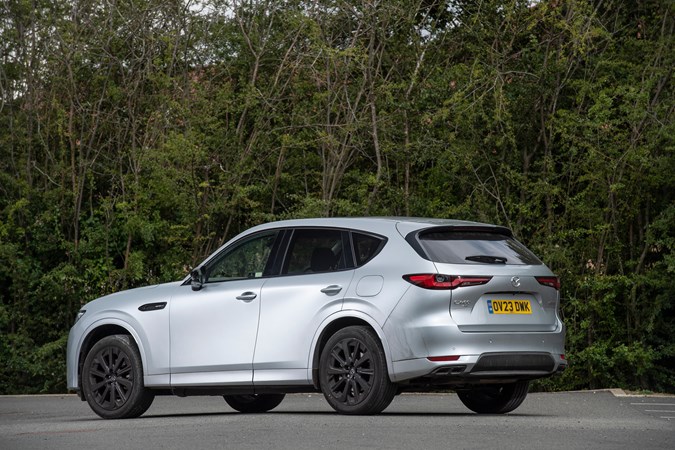
| Mazda CX-60 3.3 diesel Homura | |
| Current mileage | 7945 |
| Real-world average fuel economy | 42.9mpg |
| Official combined fuel economy (WLTP figures) | 53.3mpg (weighted) |
| Parkers ‘MPP’ (Miles Per Pound) calculation | 6.8-6.9mpp (weighted) (home/public charging) |
| Car joined Parkers fleet | June 2023 |




